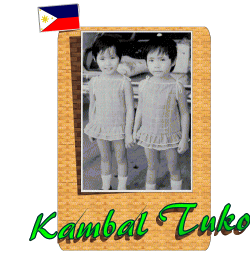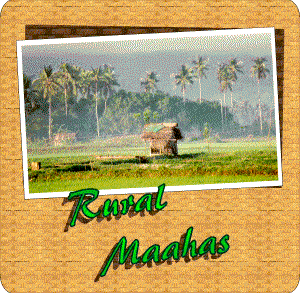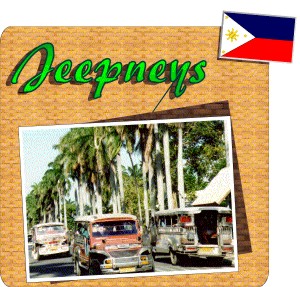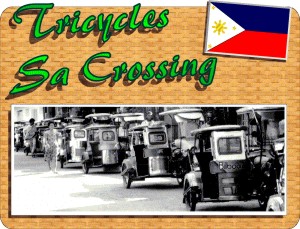Selected by Tribung Pinoy as "Best of Cyber Pinoy Site-of-the-Week!" 
[February, 1995] The travel time from San Francisco to Barangay* Maahas (snakes infested) in Los Baņos, Laguna was about 18 hours. Maahas is the place where Karen and Kathy Cruz grew up before emigrating to the United States when they were eighteen years old. In Tagalog the term for twins like Karen and Kathy is kambal. After their friends saw a movie about Siamese twins they began to call the twins kambal tuko (a gecko that sticks to windows in the province). American Filipinos sometimes refer to their home as P.I. (the Philippine Islands). This text was written by Karen and her husband, who saw the Philippines with American born and raised eyes though what he saw and learned was opened up to him by kambal and their friends' experiences.

[* With the exception of this introductory section where I talk about the Philippines of kambal's memory, I have used the term barangay throughout the text, but it is interchangeable with barrio. Barangay was used specifically because it is a Tagalog word whereas barrio is a Spanish loan word. Barangay is supplanting barrio in the nomenclature of the government as a half-hearted move to "Tagalocize" the Filipino vocabulary.]
Laguna is one of the 76 provinces in the Philippines and is located directly south and southeast of Manila. Its borders stretch along the southern portion of Laguna de Bay. There are three seasons here: the hot summer from March to May; the rainy season from June to December; and the cool season from December to March. Even during the cool season, the mercury is unlikely to drop below 70° Fahrenheit but you will see Filipinos change their shorts for long pants and tsinelas (thongs) for covered shoes. Unlike many places in Asia, where businessmen have donned the western business suit, In the Philippines the businessman and government official can still be seen wearing the comparatively practical barong tagalog which is adapted to the weather and commonly made from the pineapple plant. Laguna, as much of the Philippines, is covered with lush, tropical vegetation.
The most common type of tree found there is the palm tree which the inhabitants have found numerous uses for: buko (young coconut) pie and buko juice; tuba and lambanog, homemade fermented and distilled liquors made from the palm tree; copra (made from mature coconuts); bunot (coconut husk) used as firewood and as an abrasive for bringing cement and wood floors to a waxy shine; palm leaves are used in building a shack store known as a tindahan; walis ting-ting, a broom used outdoors or on rough surfaces; and coco-lumber.

The most common food found on a table in the Philippines is rice. Whether it is the rice known as palay (rice before it is husked), bigas (husked, but uncooked rice), kanin (cooked rice), lugaw (rice soup), gotos (lugaw with pork), arroz caldo (soup with sauteed rice and chicken), or tsamporado (sweet rice porridge with chocolate), rice is the supreme crop and food that is found with almost any meal.
When kambal left Laguna in 1986, the Hi-way which leads to the capital of the province was paved, but dirt roads were just beginning to be paved over. The ilog (river) which ran through Barangay Maahas was a place where women would gossip as they washed their families' clothes, where kalabaw (water buffalo) were washed, and where people would often relieve themselves since their were no public toilets, or comfort rooms.
Barangay Maahas is located in the city of Los Baņos, a famous resort town as well as the location of the world renowned International Rice Research Institute (IRRI) and the University of the Philippines (U.P) campuses. Kambal estimates that the barangay had grown by as much as four times between 1975, and when they left in 1986. The population totaled 3,200 in the 1990 census. Electrical workers could be seen fixing lines and broken street lamps on occasion, but their presence was infrequent. The street lamps were broken by children with sling shots and these lamps would remain broken for some time. There were no gas lines, and residents in the barrio had to purchase propane gas cans to hook up their stoves at home or cook with charcoal. Kambal never saw a fire while growing up in Maahas, and there was no standing fire department in the area. There were no public phones, phones in businesses, or even phones in the schools. In fact the only two phones in Barrio Maahas were owned by the two most prominent families who happened to live near Hi-way.

(transportation)
Cars can be seen in Laguna as can people walking, but the most common forms of transportation are the tricycle and jeepney for short to medium distances, and busses for longer distances. Cars are too expensive for the average Filipino living in the Province, but the most available car is called an "owner." This is a car that is made with the same type of body as the jeepney, but has a design of a regular jeep. You can either have one custom assembled for you or assemble it on your own. One of Kambal's friends had assembled one himself with the cost of materials estimated at P25,000 (US$1000).
 (Taxis)
(Taxis)
You've just landed at Ninoy Aquino International Airport in Manila, and are a bit dazed by the sites, sounds and smells as you exit the terminal. Someone approaches you and politely asks if you need a taxi. You say, "yes," and follow the man with your wife as he leads you past several taxis. He finally waves to a taxi who drives up and then he decides to help you with your luggage. You enter the vehicle and you're on your way. Curiously you notice there is no meter in the taxi (taxis in Manila normally have used-Japanese meters which show the fare in Yen though the price really reflects Peso fare; they assess a surcharge for air conditioning) so you ask the driver how much the fare is to your destination. He opens up a small booklet with destinations and prices typed in U.S. dollars. Then he tells you that the price is US$30 per person. Fortunately your wife was raised in the Philippines and knows that you've been setup. She realizes that this journey which will be costing you about P750 per person would normally cost P50 for the two of you. She asks for the driver to stop so you both can get out before it is too late and offers to give him P5, but he refuses in mock anger. Having agreed beforehand not to enter another taxi until you know the fare, you hail a taxi and your wife asks the driver how much the fare will be to go to your destination. He says the fare will be P400, so she declines. Then he begins to reduce the price substantially once then several times, but she ignores him the entire time. You both see a bus and she hails it. The driver stops and she asks the conductor in Tagalog if the bus was going in your destination, a bus terminal. You find out it is indeed and you both get on board before learning that the price is P2 for the both of you!


Within a provincial town, and between contiguous towns, jeepneys are the most common form of transportation. Tricycles compete with jeepneys for business within towns. A ride is inexpensive enough not to walk short distances (P1, 50 centimos for a short jeepney ride; P2 for a tricycle ride), and during the rain season and oppressive hot season there is additional incentive. The passengers bow their heads and women always place one hand over the opening of their blouse when entering the back of the jeepney where passengers sit in two long columns of seven (a comfortable ride) to nine passengers (a very crammed-in ride), facing each other. Everyone hands their fare to the driver with an "ito bayad," (here is the fare) "bayad ko;- dalawa;- tatlo;- apat," (my payment; payment for two; -three;- four), or a "bayad daw" (someone's payment) if the rider is not close enough to hand the money directly to the driver. In the last case, the money is passed up-and change returned-the same route. Remarkably, in two months I never saw a conflict arise over someone's fare being handled by so many people from passenger to driver and back, even given the fact that drivers often wait a few minutes to return change. The passengers are invariably polite when someone gets on board and they need to make room, which they automatically do so without being asked even if it means they will be slightly more uncomfortable. Passengers can exit anytime before the final stop with the impolite "pssst, pssst" and a knock on the roof of the jeepney (which is often ignored so usually followed up with a "...para!"), or the more polite "para" (stop), "sa tabi" (the side), or "sa kanto (the corner).


Tricycles are small motorcycles with customized side-cars. The motorcycle seat which fits two behind the driver as well as the side-car are always covered. The side-car normally fits two, but tricycles can carry as many people as really want to ride one. I saw one tricycle with ten children, some where standing on the back fender and holding onto the roof of the side-car. If you hire a tricycle at the end or beginning of their route, they will often wait until their vehicle is filled before beginning the journey.

Pedicabs, bicycles with sidecars, are infrequently seen in Manila and even a rarer sight in Laguna.

Some enterprising boys build trolies (taken from the English word "trolley") which they use to carry passengers along a stretch of railroad track. In some places this is a more convenient form of transportation than a jeepney or tricycle because the track may be a more direct route than taking a road. The trolie ride in Barangay San Antonio was only a few hundred yards long, but the operators were able to charge P1, 50 centimos per passenger. The trolies seat about four passengers and are operated by a boy pushing off the ground with one foot while the other foot is planted on the back of the trolie, similar to how a skateboard is operated except the boy holds onto the back of the trolie seat as he goes. One boy, nicknamed Luga (luga means "earwax," because he was usually seen with luga pushing out from the opening of his ears), operated his trolie on the weekends and like the other operators his earnings were not spent on candy or toys but on food.

